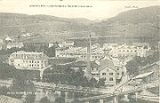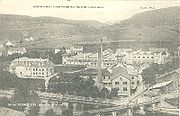
Pernod Fils
Encyclopedia
Pernod Fils was the most popular brand of absinthe
throughout the 19th century until it was banned in 1915. During the Belle Époque, the Pernod Fils name became synonymous with absinthe, and the brand represented the de facto standard of quality by which all others were judged.
that Dr. Pierre Ordinaire created a distilled patent medicine that would represent the earliest origins of the drink. The recipe then came into the hands of Henri Louis Pernod through the means of a business deal, and in 1797, he and Daniel Henri Dubied opened the first absinthe distillery in Couvet
, Switzerland.
Pernod later built a larger distillery in Pontarlier
, France
in 1805. This set the stage that would cause the sleepy community of Pontarlier to eventually emerge as the home of twenty-eight commercial absinthe distilleries, and the world's center of absinthe production.

By 1910, France's rate of absinthe consumption had topped some 36 million liters per year. With a temperance movement
growing around the world, many prominent French
politicians and scientists turned their interest to France's 'national drink'.
, melissa
and anise
in a neutral spirit of agricultural origin (usually wine) in a copper alembic
where the mixture was then distilled
, to produce a transparent liquor. Part of the distillate was then steeped with additional herbs, such as hyssop
and petite wormwood, to produce a green-colored fraction that was then filtered and reunited with the main part. The coloration process was done primarily to impart additional flavor and aroma to the absinthe, but the ensuing light olive tint also had the added benefit of enhancing its visual appeal. The colored distillate was then reduced in strength, with the 68% ABV product representing the most popular version of the brand. The predominant flavor in Pernod Fils, like all absinthes, was primarily anise - a flavor commonly misidentified by anglophones as "licorice".
, Euro Trip, Bram Stoker's Dracula, and Moulin Rouge!
, Pernod-Ricard's absinthe has enjoyed some modest success in France and other countries in the EU
.
Absinthe
Absinthe is historically described as a distilled, highly alcoholic beverage. It is an anise-flavoured spirit derived from herbs, including the flowers and leaves of the herb Artemisia absinthium, commonly referred to as "grande wormwood", together with green anise and sweet fennel...
throughout the 19th century until it was banned in 1915. During the Belle Époque, the Pernod Fils name became synonymous with absinthe, and the brand represented the de facto standard of quality by which all others were judged.
Origins
The brand's roots can be traced as far back as the 1790s. According to legend, it was during this time in Neuchâtel, SwitzerlandSwitzerland
Switzerland name of one of the Swiss cantons. ; ; ; or ), in its full name the Swiss Confederation , is a federal republic consisting of 26 cantons, with Bern as the seat of the federal authorities. The country is situated in Western Europe,Or Central Europe depending on the definition....
that Dr. Pierre Ordinaire created a distilled patent medicine that would represent the earliest origins of the drink. The recipe then came into the hands of Henri Louis Pernod through the means of a business deal, and in 1797, he and Daniel Henri Dubied opened the first absinthe distillery in Couvet
Couvet
Couvet was a municipality in the district of Val-de-Travers in the canton of Neuchâtel in Switzerland. It is claimed that Couvet was the birthplace of absinthe at the end of the 18th century and it is now the home of La Clandestine Absinthe. It was also the home to Edouard Dubied & Co...
, Switzerland.
Pernod later built a larger distillery in Pontarlier
Pontarlier
Pontarlier is a commune and one of the two sub-prefectures of the Doubs department in the Franche-Comté region in eastern France.-History:...
, France
France
The French Republic , The French Republic , The French Republic , (commonly known as France , is a unitary semi-presidential republic in Western Europe with several overseas territories and islands located on other continents and in the Indian, Pacific, and Atlantic oceans. Metropolitan France...
in 1805. This set the stage that would cause the sleepy community of Pontarlier to eventually emerge as the home of twenty-eight commercial absinthe distilleries, and the world's center of absinthe production.
The Golden Age of Absinthe
The popularity of the Pernod Fils brand surged in the decades that followed, its impressive market share spawning a string of knock-offs and imitators with deceptive brand names such as "Pernot", "Parrot" and "Pierrot", among others. In 1901, the original distillery was almost completely destroyed by fire. A new, larger and more modern distillery was built in its place. In its heyday, the Pernod Fils distillery was producing as much as 30,000 liters of absinthe per day, and was exporting its product around the world.
By 1910, France's rate of absinthe consumption had topped some 36 million liters per year. With a temperance movement
Temperance movement
A temperance movement is a social movement urging reduced use of alcoholic beverages. Temperance movements may criticize excessive alcohol use, promote complete abstinence , or pressure the government to enact anti-alcohol legislation or complete prohibition of alcohol.-Temperance movement by...
growing around the world, many prominent French
France
The French Republic , The French Republic , The French Republic , (commonly known as France , is a unitary semi-presidential republic in Western Europe with several overseas territories and islands located on other continents and in the Indian, Pacific, and Atlantic oceans. Metropolitan France...
politicians and scientists turned their interest to France's 'national drink'.
Product Attributes
Like most quality absinthes, Pernod Fils was produced by macerating herbs, including wormwood, fennelFennel
Fennel is a plant species in the genus Foeniculum . It is a member of the family Apiaceae . It is a hardy, perennial, umbelliferous herb, with yellow flowers and feathery leaves...
, melissa
Melissa (plant)
Melissa is a genus of five species of perennial herbs native to Europe and Asia. The name Melissa is derived from a Greek word meaning bee, owing to the abundance of nectar in the flowers which attracts bees. The stems are square, like most other plants in the mint family...
and anise
Anise
Anise , Pimpinella anisum, also called aniseed, is a flowering plant in the family Apiaceae native to the eastern Mediterranean region and Southwest Asia. Its flavor resembles that of liquorice, fennel, and tarragon.- Biology :...
in a neutral spirit of agricultural origin (usually wine) in a copper alembic
Alembic
An alembic is an alchemical still consisting of two vessels connected by a tube...
where the mixture was then distilled
Distillation
Distillation is a method of separating mixtures based on differences in volatilities of components in a boiling liquid mixture. Distillation is a unit operation, or a physical separation process, and not a chemical reaction....
, to produce a transparent liquor. Part of the distillate was then steeped with additional herbs, such as hyssop
Hyssop
Hyssop is a genus of about 10-12 species of herbaceous or semi-woody plants in the family Lamiaceae, native from the east Mediterranean to central Asia. They are aromatic, with erect branched stems up to 60 cm long covered with fine hairs at the tips. The leaves are narrow oblong, 2–5 cm...
and petite wormwood, to produce a green-colored fraction that was then filtered and reunited with the main part. The coloration process was done primarily to impart additional flavor and aroma to the absinthe, but the ensuing light olive tint also had the added benefit of enhancing its visual appeal. The colored distillate was then reduced in strength, with the 68% ABV product representing the most popular version of the brand. The predominant flavor in Pernod Fils, like all absinthes, was primarily anise - a flavor commonly misidentified by anglophones as "licorice".
The Demonization and Banning of Absinthe
The sheer popularity of absinthe indirectly contributed to its own demise. The absence of a proper appellation of control and regulated production standards invited cheap, industrial versions of the drink into urban markets. These poor quality absinthes appealed to alcoholics of low socioeconomic status, and were commonly adulterated with a variety of toxic substances to make certain attributes (e.g. color) of these inferior brands more convincing. This opened the door for the detractors of absinthe to accuse the drink of being harmful and deleterious, making it a convenient scapegoat for societal ills. Scientists conducted studies involving the injection of pure wormwood essence into small animals. And while this practice usually resulted in convulsions followed by the death of the animal, these tests were flawed and unrepresentative of absinthe consumption. Despite pleas by absinthe distillers for quality regulations for the category, the enemies of absinthe pushed to ban the popular drink. By 1915, absinthe was banned throughout much of Europe and the world. All French absinthe distilleries closed their doors, which caused the demise of Pernod Fils in France.Post-Ban Years
Despite the ravages of the French ban and the subsequent First World War, Pernod Fils' absinthe did not completely disappear. Production was resumed on a smaller scale at the Banus distillery in Tarragona, Spain, where absinthe had never been formally banned. However, the drink never regained its former popularity, and by the 1960s, production of Pernod's absinthe was ceased. Concurrently in France, the Pernod company began producing a liqueur d'anise (anise liqueur) in the years that followed the First World War, and it is this product which has evolved over the decades into its familiar present-day incarnation. Modern day Pernod liqueur d'anise is altogether different than its predecessor, being compounded from a modern, industrial process, being significantly lower proof (45% ABV vs 68% ABV) with a much different flavor profile, and bottled with artificial dye and sugar.Today
Today, following the relegalization of absinthe in various markets, the modern day giant, Pernod-Ricard, has released an absinthe made from extracts and colorants and claimed to be "inspired by the old formula". However, independent reviews reveal this product to be far more similar to its cousin, the contemporary Pernod liqueur d'anise, than the historic pre-1915 drink. With absinthe gaining some commercial exposure by appearing in a range of movies, including From HellFrom Hell (film)
From Hell is a 2001 American crime drama horror mystery film directed by the Hughes brothers. It is an adaptation of the comic book series of the same name by Alan Moore and Eddie Campbell about the Jack the Ripper murders.-Plot:...
, Euro Trip, Bram Stoker's Dracula, and Moulin Rouge!
Moulin Rouge!
Moulin Rouge! is a 2001 romantic jukebox musical film directed, produced, and co-written by Baz Luhrmann. Following the Red Curtain Cinema principles, the film is based on the Orphean myth, La Traviata, and La Bohème...
, Pernod-Ricard's absinthe has enjoyed some modest success in France and other countries in the EU
European Union
The European Union is an economic and political union of 27 independent member states which are located primarily in Europe. The EU traces its origins from the European Coal and Steel Community and the European Economic Community , formed by six countries in 1958...
.
External links
- The Virtual Absinthe Museum- A comprehensive online museum of absinthe history, lore, art and antiques.

